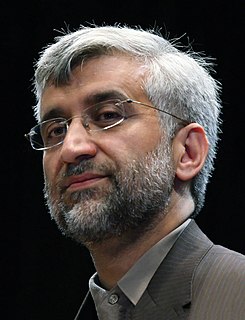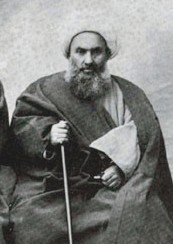
Mohammad Reyshahri, also known as Mohammad Mohammadi-Nik,, best known as Reyshahri, is an Iranian politician and cleric who was the first Minister of Intelligence, served from 1984 to 1989 in cabinet of Prime Minister Mir-Hossein Mousavi.
The Council of the Islamic Revolution was a group formed by Ayatollah Ruhollah Khomeini to manage the Iranian Revolution on 10 January 1979, shortly before he returned to Iran. "Over the next few months there issued from the council hundreds of rulings and laws, dealing with everything from bank nationalization to nurses' salaries." Its existence was kept a secret during the early, less secure time of the revolution, and its members and the exact nature of what the council did remained undisclosed to the public until early 1980. Some of the council's members like Motahhari, Taleqani, Bahonar, Beheshti, Qarani died during Iran–Iraq War or were assassinated by the MKO during the consolidation of the Iranian Revolution. Most of those who remained were put aside by the regime.

Saeed Jalili is an Iranian conservative politician and diplomat who was secretary of the Supreme National Security Council from 2007 to 2013. He was also Iran's nuclear negotiator. He was previously deputy foreign minister for European and American Affairs. Jalili was an unsuccessful candidate in the June 2013 presidential election, placing third.

Clericalism in Iran has a long history and had remarkable impact on Iranian society, politics as well as on Islamic theology.
Government of Mohammad-Ali Rajai was the first government of Iran after the Iranian Revolution. At that time, Abolhassan Banisadr was president and Mohammad-Ali Rajai was prime minister.

Mostafa Kavakebian is an Iranian reformist politician and representative of Tehran at the Parliament of Iran. He was formerly represented Semnan and Mehdishahr in the parliament from 2008 until 2012.

Presidential elections were held in Iran on 14 June 2013. Hassan Rouhani won with a landslide victory, elected in the first round of voting with 50.71% of the vote. Tehran Mayor Mohammad Bagher Ghalibaf finished second with 16.56% of the vote. Over 36.7 million Iranians voted, 72.71% of eligible voters.

Sayyid Shahab od-Din Sadr is an Iranian physician and principlist politician.
The following lists events that happened during 2013 in the Islamic Republic of Iran.
Seyed Shamseddin Mojabi was an Iranian academic, government adviser and political activist. He was an adviser to Ayatollah Khomeini during his stay in Neauphle-le-Château on the outskirts of Paris, France in 1978.

Front of Followers of the Line of the Imam and the Leader, formerly known as Islamic Aligned Organizations is a Coalition of Iranian Principlist political groups. The group which consists of a wide range of traditional conservative parties, is active since administration of Mohammad Khatami, and is aligned with The two Societies.
The Council for Coordinating the Reforms Front or the Reformist Front Coordination Council is the umbrella organization, coalition and council of main political groups within the Iranian reform movement. Since 2015, it is overseen by the Reformists' Supreme Council for Policymaking.
Front of Transformationalist Principlists is an Iranian principlist political group, consisting of Society of Devotees of the Islamic Revolution and Society of Pathseekers of the Islamic Revolution.

The Coalition of the Pleasant Scent of Servitude or Sweet Scent of Servitude was an Iranian principlist political group supporting Mahmoud Ahmadinejad and his government.

Mostafa Hashemitaba is an Iranian reformist politician. Hashemitaba served as Iran's minister of industries and vice president, as well as head of National Olympic Committee of Iran. He is described as having 'centrist' views.































